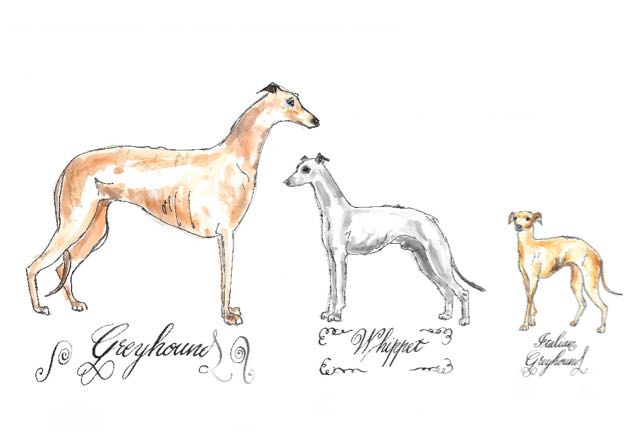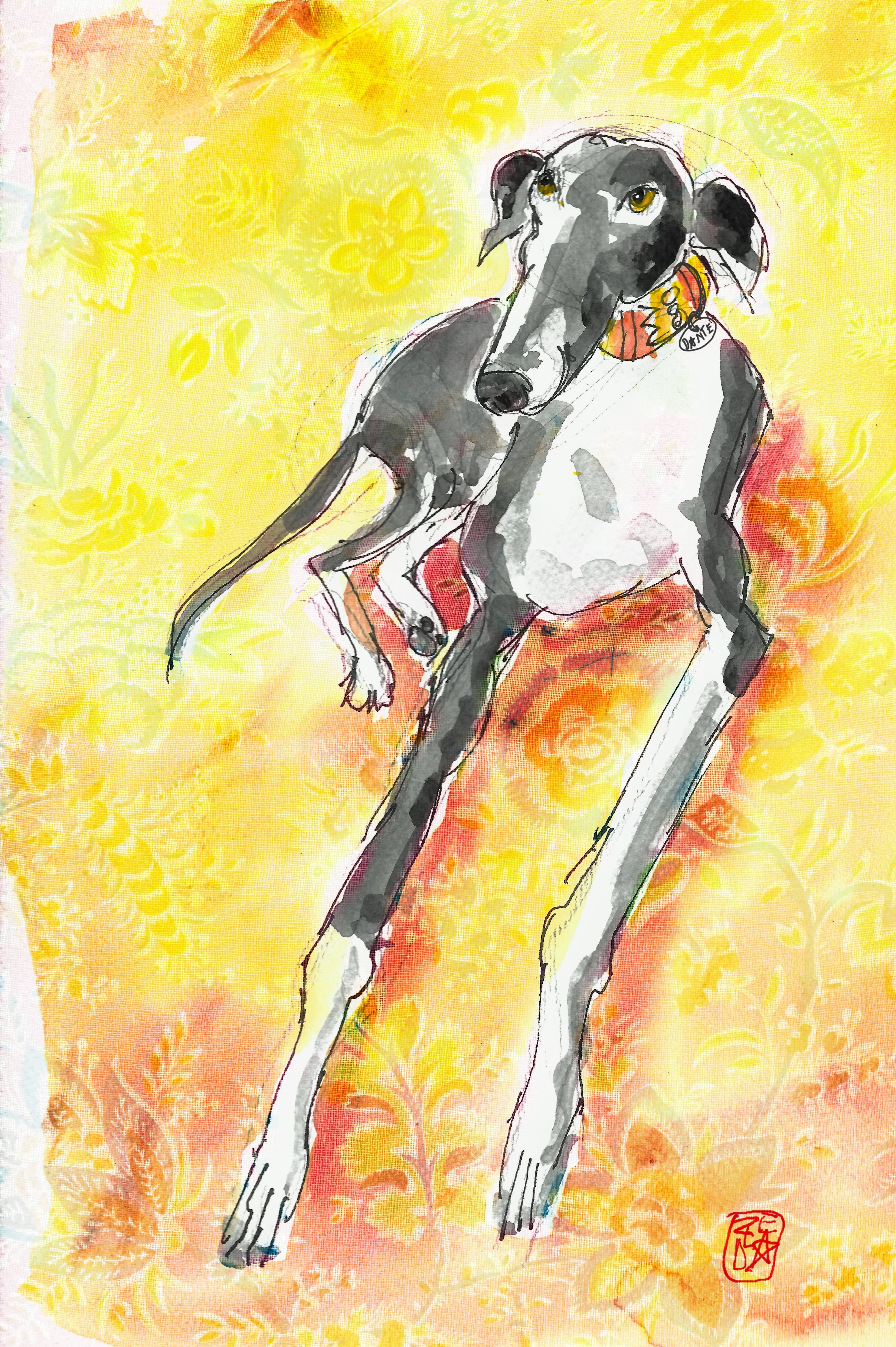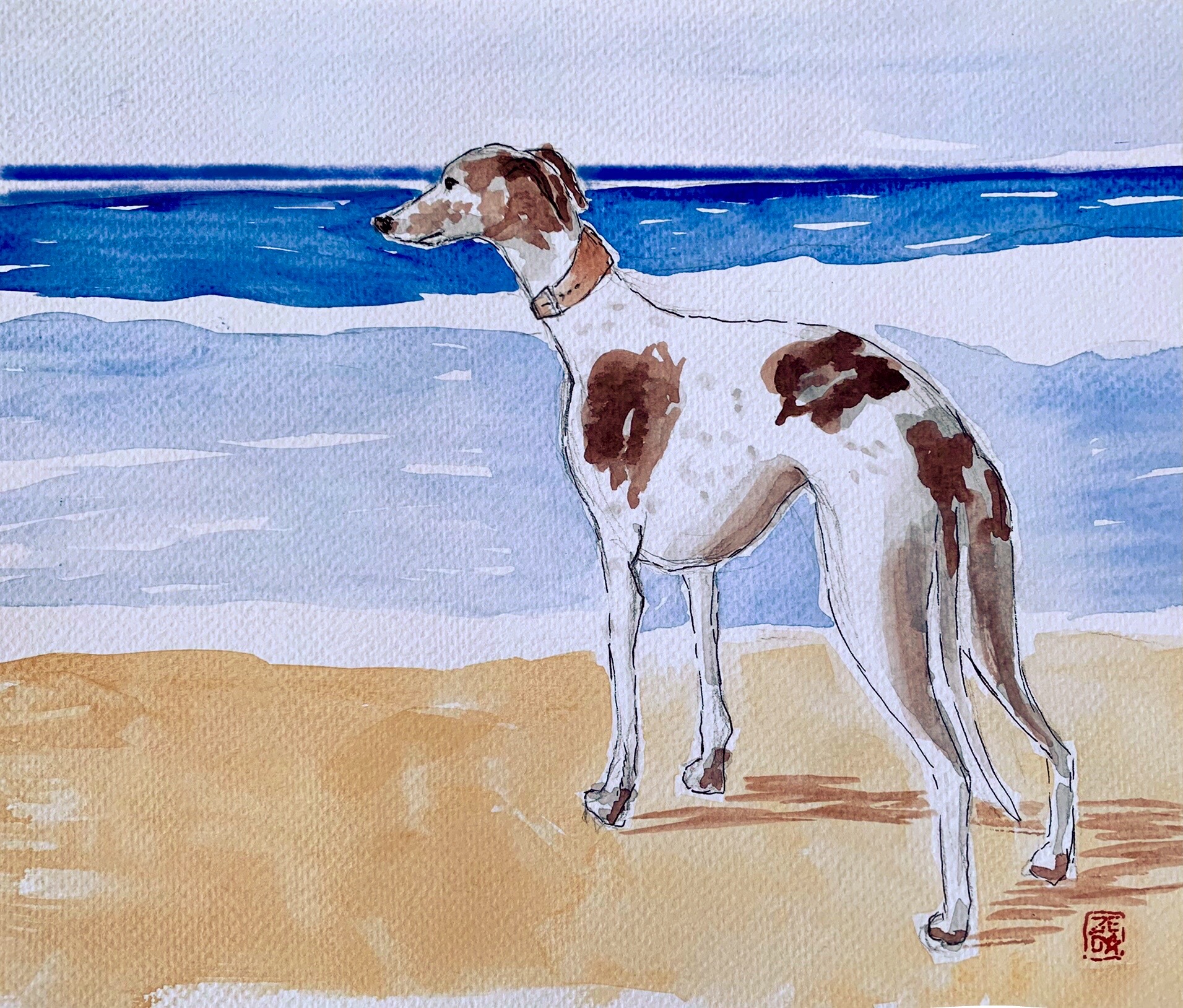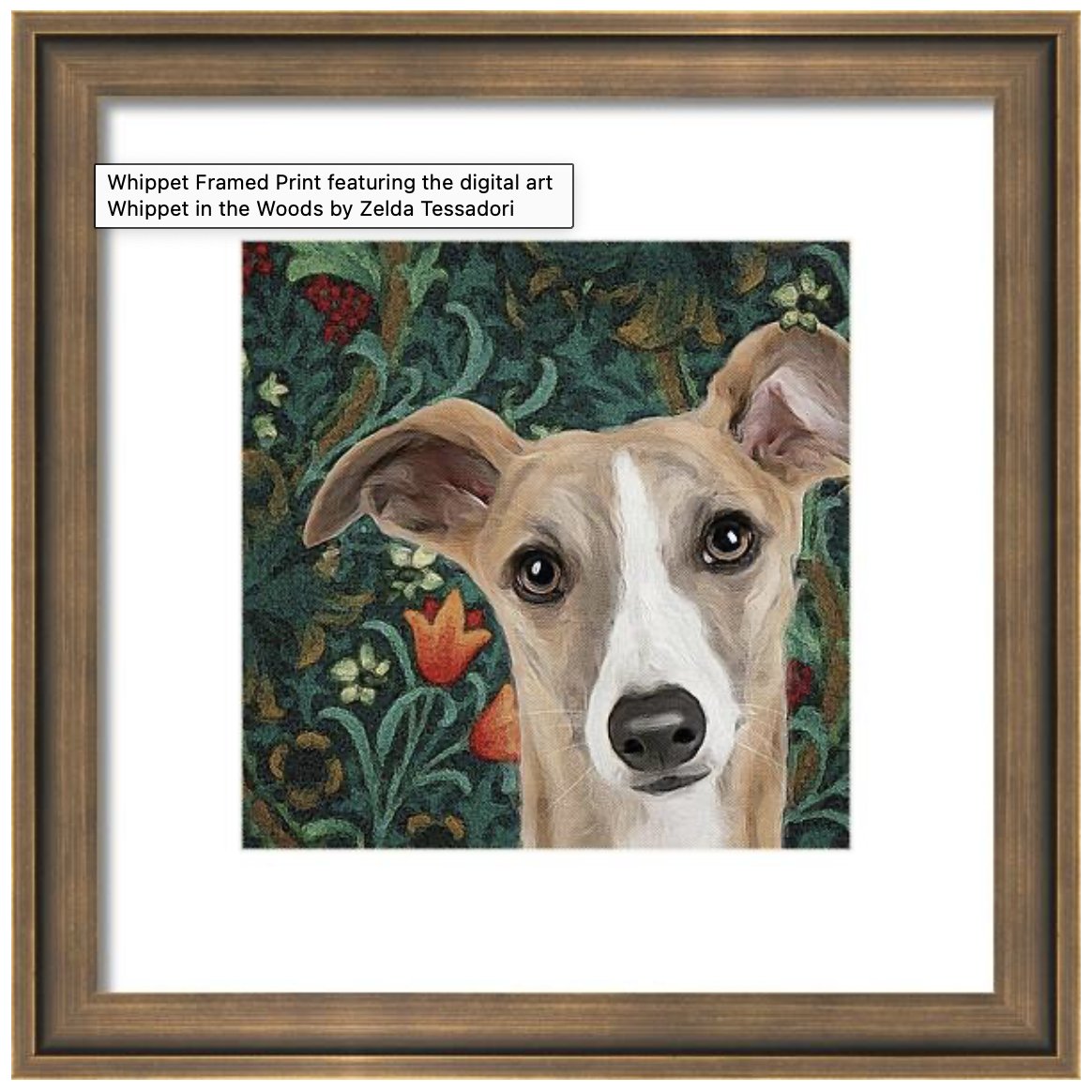Do you have a whippety question? Enter here your query or keyword.
- Home
- Whippet Info
- Greyhound Whippet Italian Greyhound
Greyhound, Whippet, Italian Greyhound: Differences and Similarities
Greyhound, whippet and Italian greyhound: compare these three dog breeds and find your perfect match.
Greyhounds, whippets and Italian greyhounds are all sighthounds, a breed of dog primarily bred for hunting and running due to their exceptional vision and speed. While these three breeds share some similarities, there are distinct differences in their size, weight, body proportions, colours, origins, and temperaments.
These hounds almost look the same dog breed in three different sizes but actually their history, attitudes and development set them apart and their differences run a lot deeper than what you would see immediately.
Size

When comparing greyhound, whippet and Italian greyhound, the most noticeable difference is their size. Greyhounds are the largest of the three, with males standing around 28 to 30 inches (71 to 76 cm) at the shoulder and females slightly shorter. They typically weigh between 60 to 70 pounds (27 to 32 kg), though some racing greyhounds can be slightly lighter.
In contrast, whippets are medium-sized dogs, smaller than greyhounds but larger than Italian greyhounds. They stand about 18 to 22 inches (46 to 56 cm) tall at the shoulder and weigh between 25 to 40 pounds (11 to 18 kg). Whippets are built for speed but are more compact than greyhounds, making them a little easier to keep in smaller living spaces.
The Italian greyhound is the smallest of the three, standing just 13 to 15 inches (33 to 38 cm) at the shoulder and weighing between 7 to 14 pounds (3 to 6 kg). Their size is one of the reasons they are often favored as lap dogs or companions. Despite their petite frame, Italian greyhounds retain the same sleek and athletic build as their larger relatives.
Proportions
The body proportions of these three breeds are one of the key features that highlight their different purposes and athletic abilities. A greyhound's body is long and lean, with a deep chest and slim waist. This slimness, paired with their long legs, makes them built for speed and stamina. Their body proportions allow them to achieve incredible speeds of up to 45 miles per hour (72 km/h), making them one of the fastest dog breeds in the world.
Whippets, while also lean and fast, have slightly shorter legs and a more compact body than greyhounds. Their body is still streamlined for speed, but they are less extreme in their build. Whippets are often referred to as "miniature greyhounds," and their body proportions reflect this similarity. However, their slightly smaller size and proportions make them more adaptable to various environments, including homes with smaller yards.
The Italian greyhound shares the same elegant and refined body proportions as the greyhound, but in a much smaller package. Their long legs and slim, curved bodies are designed for speed, even though they are not as fast as the larger greyhound. They are known for their graceful and delicate appearance, often being described as one of the most elegant dog breeds. Their body proportions make them excellent runners, though they are generally more suited for indoor environments due to their smaller size and delicate build.
As you can see in the picture above, the ribcage in the whippet is about the double length of that of the loin.
In the Italian greyhound the two length are approximately the same, giving the hound a shorter look.
On another hand in the greyhound the length of the ribcage is more or less three times that of the loin with the result of a longer dog.
Colors
Greyhound, whippet and Italian greyhound can all come in a variety of colours, although there are some differences in the typical colours seen within each breed.
Greyhounds come in many colours, including black, white, fawn, brindle, blue, and various combinations of these. They may also have markings, such as white patches on their chest, feet, or tail. The variety of colours found in greyhounds is extensive, as they have been bred for racing and hunting purposes across the world, contributing to the wide array of coat hues.
Whippets also come in a diverse range of colours, including solid, brindle, and patterns like piebald (white with patches of another colour). Common colours for whippets include black, blue, fawn, red, and various shades of grey. Whippets, like greyhounds, can have intricate markings, which are often seen in racing whippets, where their appearance can also reflect their pedigree.
Italian greyhounds, with their delicate and fine coats, are typically seen in a more limited but still varied colour range. They can be found in colours such as fawn, blue, black, white, and even a combination of these colours but sorry, no brindles! .
The colours allowed for each breed are not the same, as stated in each official standard. For the whippet and greyhound anything goes!
Origins

The history of the three breeds could not be more different.
The greyhound, whippet and Italian greyhound all trace their origins to ancient times, where they were bred for hunting purposes due to their exceptional vision and speed.
The greyhound is one of the oldest and most recognizable dog breeds, dating back thousands of years to ancient Egypt. Depictions of greyhounds can be found in Egyptian art, and they were highly prized by the nobility for their hunting abilities, particularly in the pursuit of game such as hares and deer. Greyhounds have been bred for speed and endurance, which is why they remain a popular breed for racing today.

The whippet is believed to have originated in England in the 19th century. Whippets were bred by crossing greyhounds with smaller terrier-type dogs to create a faster, more agile dog for hunting small game like rabbits. While whippets were bred to be excellent hunters, their friendly and adaptable nature also made them excellent companions, and they have become a popular choice as pets in many households.
The Italian greyhound has a rich history dating back to ancient Rome. It is thought that they were first bred by the Romans as companions to the aristocracy. Known for their elegance and grace, Italian greyhounds were prized as lapdogs, often found in the homes of nobility. Unlike their larger relatives, the Italian greyhound was not primarily bred for hunting but for companionship, though they still retained the speed and agility of their greyhound ancestors.
Temperament and Attitudes
While all three breeds—greyhound, whippet and Italian greyhound—share a calm and affectionate nature, there are slight differences in temperament due to their history and size.
The greyhound is known for its gentle and friendly temperament. Despite their impressive speed, greyhounds are often referred to as "couch potatoes" due to their relaxed attitude. They enjoy lounging and are generally calm indoors. However, they also have bursts of energy and require regular exercise to stay healthy. They tend to be good-natured with other dogs and children, making them great family pets.
The whippet is often described as playful, friendly, and affectionate. Whippets are slightly more energetic than greyhounds but still enjoy long periods of relaxation. They form strong bonds with their owners and are particularly good with children and other pets. Whippets tend to be a little more adaptable to various living situations than greyhounds, due to their smaller size and less intense exercise requirements.
The Italian greyhound, while similar in temperament to its larger relatives, is a bit more sensitive and delicate. They are affectionate, loyal, and enjoy being close to their owners. However, due to their smaller size, Italian greyhounds can sometimes be more timid or shy, especially around larger dogs or in unfamiliar situations. They are also known for their alertness and can be a bit more reserved with strangers compared to greyhounds and whippets.
Uses
Greyhounds, whippets and Italian greyhounds, while sharing a common ancestry as sighthounds, have slightly different uses today.
Greyhounds are still widely used in racing and are also bred for hunting in some regions. Their speed, stamina, and excellent vision make them ideal for chasing game. However, many greyhounds today are also cherished as companion animals, especially after their racing careers are over.
Whippets are often kept as companion animals and for performance in activities like lure coursing, where their hunting instincts and speed are put to the test in a controlled environment. Their friendly and adaptable nature also makes them great pets for families and individuals who lead an active lifestyle.
Italian greyhounds, on the other hand, are primarily kept as companion dogs. Due to their affectionate nature and elegant appearance, they are ideal lapdogs, often found in homes where they can enjoy the company of their owners in a calm environment. Though they retain their sighthound instincts, their smaller size makes them less suited for hunting.
In summary, while greyhound, whippet and Italian greyhound share some common traits as sighthounds, they each have unique characteristics that set them apart. Whether you are looking for a fast and agile hunter, a playful companion, or an elegant lapdog, there is a breed that fits every lifestyle. Understanding these differences and similarities can help you choose the perfect dog for your home.
Greyhound Whippet Italian Greyhound are Not For...
Greyhound: unfenced yards, automatic obedience, off-leash romp
Whippet: outdoor living, unfenced yards
Italian greyhound: kennel life, rowdy children
Conclusion
In summary, while greyhound, whippet, Italian greyhound share some common traits as sighthounds, they each have unique characteristics that set them apart. Whether you are looking for a fast and agile hunter, a playful companion, or an elegant lapdog, there is a breed that fits every lifestyle. Understanding these differences and similarities can help you choose the perfect dog for your home.



